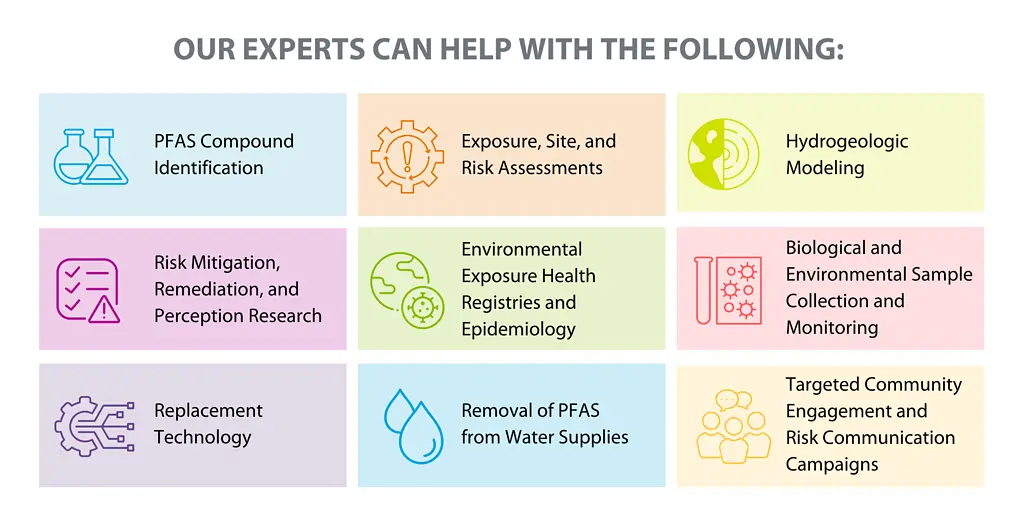Providing technical research support to identify and mitigate environmental health concerns from “forever chemicals”
What are Per- and Polyfluoroalkyl Substances (PFAS)?
Per- and polyfluoroalkyl substances (PFAS) are a class of human-made compounds that are rapidly becoming an emerging public health concern. Some PFAS compounds have been used for decades in common consumer and industrial products such as non-stick cookware, food containers and food paper wrappings, carpeting, upholstery, clothing, and firefighting foams. The use of per- and polyfluoroalkyl substances makes materials more resistant to grease, water, and oil. Although some PFAS, including perfluorooctane sulfonic acid (PFOS) and perfluorooctanoic acid (PFOA), are no longer produced in the United States, these compounds are extremely stable and therefore persist in the environment and human body for extended periods of time. Additionally, newer per- and polyfluoroalkyl substances have been used as replacements and the toxicity and persistence of these emerging contaminants is not fully understood.
Why is PFAS Research Increasing?
PFAS are in the human body.
Data from the National Health and Nutrition Examination Survey demonstrate that most adolescents and adults have detectable levels of PFAS in their blood (CDC, 2018). However, the correlation between environmental exposure and blood serum levels is not well understood.
PFAS are in the environment.
Data on PFAS in some environmental media such as air, food, and indoor dust are limited, but sites with elevated levels in drinking water continue to emerge. PFAS compounds have been identified in drinking water derived from both surface water and groundwater sources. In March 2023, EPA announced that they are proposing a national drinking water standard for six PFAS. The proposal, if finalized, would require public water systems to monitor for these chemicals.
Little is known about PFAS toxicity and its long-term effects on humans and the environment.
According to EPA, scientific research has shown that exposure to certain levels can cause decreased fertility in women, developmental delays in children, and increase risk of some cancers. In 2016, the EPA issued a lifetime health advisory for PFOS and PFOA of 70 parts-per-trillion (EPA 2016a; EPA 2016b). The Agency for Toxic Substances and Disease Registry (ATSDR) has since released advisories proposing much lower minimum risk levels for PFAS and PFOA (ATSDR, 2018b).
How Does RTI’s Research Help Address Per- and Polyfluoroalkyl Substances?
RTI has more than 30 years of experience evaluating hazardous, industrial, and municipal waste management practices and assessing human health impacts from pollutants released in the environment. Our programs provide the comprehensive, scientific expertise needed to assess PFAS exposure and its impact on communities. We have a large group of subject matter experts with a broad range of expertise on environmental health science, laboratory science, and policy analysis on PFAS compounds.
Download our capabilities brochure and contact our team to learn how we can help you.
Related Projects
Replacing Polytetrafluoroethylene (PTFE) Substances in Consumer Products
Read More about Replacing Polytetrafluoroethylene (PTFE) Substances in Consumer Products























